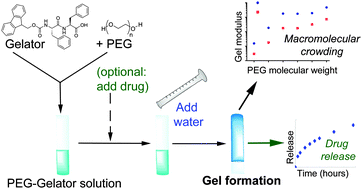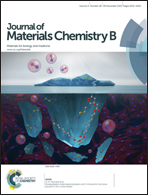Macromolecular crowding and hydrophobic effects on Fmoc-diphenylalanine hydrogel formation in PEG : water mixtures†
Abstract
A small peptide-based gelator forms stable hydrogels in an aqueous mixture with a range of poly(ethylene glycol) PEGs, from the ethylene glycol monomer to PEG 20 000 with stronger gels forming in polymeric PEG. Spectroscopic studies on these systems reveal significant secondary structural changes when compared to gels formed from pure water. The use of PEG also facilitates the incorporation and controlled release of poorly water-soluble anti-cancer drugs such as Temozolomide and Paclitaxel (Taxol®). This work provides a powerful insight into the role of macromolecular crowding and hydrophobic interactions in not only hydrogels formed from small molecules but potentially also biological gel-like materials such as the cytosol and the extracellular matrix (ECM).


 Please wait while we load your content...
Please wait while we load your content...